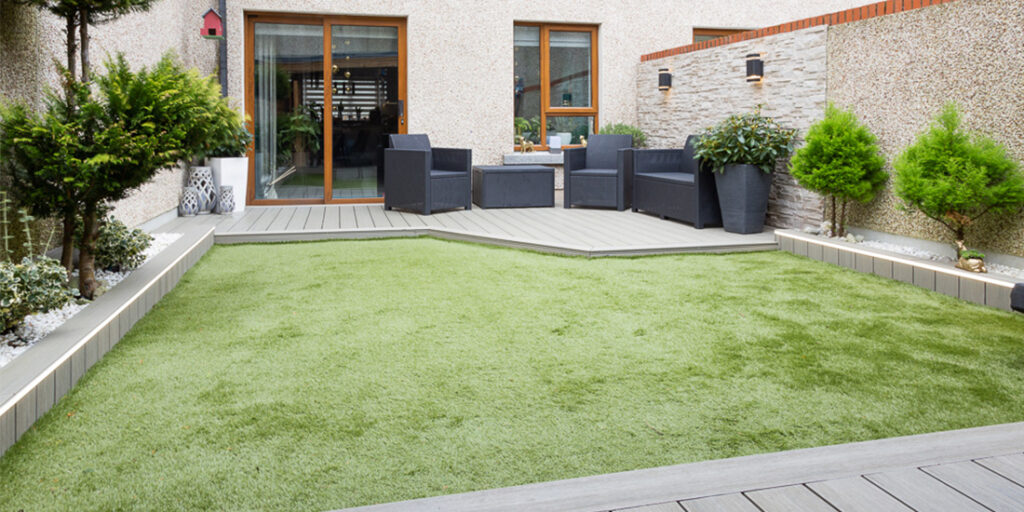When choosing between artificial grass and natural grass for your lawn or landscape, it’s essential to consider various factors such as maintenance, cost, appearance, and environmental impact. Both options offer unique benefits and drawbacks. Here’s a comparative study to help you make an informed decision.
1. Maintenance
Artificial Grass:
- Low Maintenance: Artificial grass requires minimal upkeep. It doesn’t need mowing, watering, or fertilizing. Routine maintenance involves occasional brushing to keep the fibers upright and removing debris.
- Durability: It withstands high traffic and various weather conditions without deteriorating, making it a practical choice for busy areas.
Natural Grass:
- High Maintenance: Natural grass demands regular care, including mowing, watering, fertilizing, and weeding. This can be time-consuming and requires consistent effort throughout the year.
- Seasonal Variations: Maintenance needs vary with the seasons, and natural grass can be susceptible to issues such as browning or patchiness during extreme weather conditions.
2. Cost
Artificial Grass:
- Initial Investment: The upfront cost of artificial grass is higher compared to natural grass. This includes the cost of materials and professional installation.
- Long-Term Savings: Over time, artificial grass can be cost-effective due to reduced maintenance and water savings. It eliminates ongoing costs associated with lawn care products and services.
Natural Grass:
- Initial Cost: The initial cost of installing natural grass is generally lower, especially if you’re starting with seed or sod.
- Ongoing Expenses: Regular maintenance costs can add up over time, including water bills, fertilizers, and lawn care services. Additionally, natural grass can require costly repairs if damaged.
3. Appearance
Artificial Grass:
- Consistency: Artificial grass provides a uniform appearance year-round. It remains lush and green regardless of weather conditions or foot traffic.
- Realism: Advances in technology have made artificial grass look more realistic, but it may still lack the natural variations and texture of real grass.
Natural Grass:
- Aesthetic Appeal: Natural grass offers a classic, authentic look and feel. It provides a unique texture and can enhance the overall aesthetic of your landscape.
- Seasonal Changes: The appearance of natural grass can vary with seasons, and it may require reseeding or patching to maintain a consistent look.
4. Environmental Impact
Artificial Grass:
- Water Conservation: Artificial grass installers helps conserve water by eliminating the need for irrigation. This is beneficial in regions facing water scarcity.
- Heat Retention: Artificial grass can retain heat and become hot under direct sunlight, which might impact its comfort and contribute to urban heat islands.
Natural Grass:
- Environmental Benefits: Natural grass supports local ecosystems by providing habitat for insects and contributing to air purification. It also helps with cooling the environment through transpiration.
- Water Usage: Natural grass requires significant water for irrigation, which can be a concern in drought-prone areas.
5. Comfort and Use
Artificial Grass:
- Comfort: Artificial grass provides a consistent, cushioned surface that can be more comfortable for activities. However, it can become hot in direct sunlight, potentially affecting comfort.
- Safety: Modern artificial grass includes shock-absorbing padding to reduce the risk of injury from falls, making it suitable for playgrounds and sports fields.
Natural Grass:
- Comfort: Natural grass offers a soft, cool surface that many people find more comfortable for lounging and outdoor activities. It is also cooler to the touch compared to artificial alternatives.
- Wear and Tear: Natural grass can suffer from wear and tear, particularly in high-traffic areas, and may require reseeding or restoration.
In conclusion, the choice between artificial grass and natural grass depends on your specific needs, preferences, and environmental considerations. Artificial grass offers low maintenance, durability, and water conservation, while natural grass provides aesthetic appeal, environmental benefits, and comfort. Evaluating these factors will help you make the best decision for your lawn or landscape.
